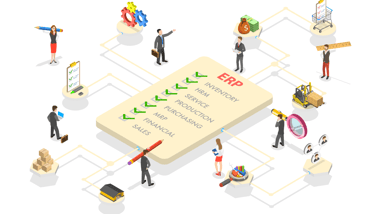How to Maximize the Value of Your NetSuite Integrations
If you’re using Oracle NetSuite as an ERP, you’re familiar with the robust host of features that make the platform a high-value addition to your organization. But what if I told you that, with a few simple Oracle NetSuite integrations, you could exponentially increase the ROI of your NetSuite.
Only about 50% of organizations see a positive ROI from their ERP implementation. Similarly, only about half of all organizations see improved business processes across the board. But you can dramatically improve your ROI with the right NetSuite integration.
Consider this your one-stop NetSuite guide to maximizing your ERP’s ROI.
What Are NetSuite Integrations?
Let’s start with the basics: what are NetSuite integrations?
NetSuite integrations are additional software and tools that can be integrated into your ERP, granting the new software access to the data stored in your NetSuite system and creating powerful synergies.
This synergistic connection between the new software and/or tool and the existing ERP platform allows your business to do more than either would be able to accomplish alone.
Some of the benefits of integrations can include:
- Automation functionality
- Deeper analysis of your data
- Uncovering oversights when implementing NetSuite
- Streamlining NetSuite budgeting and forecasting (NetSuite FP&A integration)
- Speeding up your financial data analysis processes
And more.
For too many organizations, they implement NetSuite as their ERP and think that’s it – they can step away and let the system operate as is. And they can. But by doing so, they’re missing out on all the above improvements which can save your business hundreds of hours each year and potentially uncover hundreds of thousands of dollars in hidden costs. Remember that only about half of all organizations see a positive ROI from their ERP; getting the right integration can ensure that your organization won’t lose out on all those potential benefits locked away in your ERP data.
NetSuite FP&A
All the benefits listed above are rather easily attainable – all it requires is a single type of integration: a NetSuite FP&A integration.
Typically, most mid-sized organizations use Excel to complete their financial planning and analysis activities. And Excel is effective at FP&A . . . to a point.
When an organization is smaller, you only have a few dozen Excel spreadsheets to manage, comprising all your departments, products, other streams of revenue, etc.
But as you grow, that number can quickly grow from a few dozen to a few dozen hundred.
This makes FP&A a far more taxing, time-consuming, and frustrating experience.
For instance, when working in Excel, maintaining an audit trail to ensure data integrity is practically impossible. Which is to say that each time a change is made to a spreadsheet, that new version is then iterated upon – potentially with a critical error. Sometimes, you may not discover this error until several versions have been created, requiring a meticulous combing of every previous version to find where and when the change was made, then you need to review who made the change to ensure it doesn’t happen again.
This not only saps time and productivity from your FP&A team but also saps enthusiasm. After all, no one likes to be forced to redo work they had already thought complete – especially tedious work like data integrity verification.
These issues don’t disappear with NetSuite - in fact, in certain circumstances, an ERP can exacerbate the gaps in Excel FP&A. For instance, transferring data over from your NetSuite to the Excel sheets adds another laborious step that is prone to error. And any error early on in the process of budgeting and reporting, say, could lead to the situation mentioned above where a data integrity assessment is now necessary.
This can be especially painful as you may have already performed an in-depth analysis on the data . . . only to have all that need to be redone because it was devised using inaccurate data.
Having these two siloed systems can also create massive oversights in the organization. There have been times when accounts at an organization were transferred over to NetSuite from Excel when initially implemented, but as new accounts were added later, they were entirely absent from the ERP system. In other words, there were entire segments of organizations that didn’t have their data incorporated into the ERP, weakening the effectiveness of financial planning and analysis, and leading to potential massive inaccuracies.
Worse yet, this may be occurring at your organization – and you wouldn’t even realize it.
Both these are real-world issues faced by organizations of all industries.
The good news is that a NetSuite FP&A integration can quickly solve all these issues – especially a cloud FP&A platform. And with more and more organizations opting for cloud-based ERPs to begin with, adding on cloud FP&A software as integration will eliminate the threat of the two scenarios above immediately.
NetSuite Budgeting and Forecasting Made Better
If your organization has relied on Excel in the past for FP&A, then your team is likely familiar with the look and feel of the ubiquitous spreadsheet software. But as our earlier section notes, Excel is simply not sustainable for a high-growth business. NetSuite budgeting and forecasting can be very effective - but Excel is not the tool to accomplish this.
You need an Excel replacement that allows your organization to scale upwards seamlessly.
More importantly, the right NetSuite Excel integration replacement will be able to provide a lot more than Excel. For instance, with the best NetSuite FP&A tools working with your ERP, you’ll benefit from:
- Comprehensive planning tools
- More effective collaboration tools (cloud-based FP&A platforms)
- Privacy (can assign specific budgets to specific teams, limiting visibility so that only those who need to see certain data sets are able to)
- Effective in-depth analysis
- Cloud scalability
In addition to a variety of other financial reporting NetSuite augments.
Let’s take a look at some of the NetSuite budgeting and forecasting improvements mentioned above in more detail.
Effective Planning
With the best NetSuite FP&A tools, you’ll benefit from effective FP&A but also something called xP&A - extended planning and analysis, or the process of connecting strategic, financial, and operational planning that allows for more cohesive and effective planning across your organization.
This is simply impossible to accomplish when using Excel exclusively. In fact, most organizations will complain that their Excel planning and budgeting is underperforming expectations - even with the powerful tools offered by Oracle NetSuite.
|
Learn more about FP&A software: |
But if you want to see a potentially massive boost to your ERP’s ROI, using a NetSuite FP&A integration can help you develop in-depth forecasting plans. You can leverage the best NetSuite FP&A tools to create what-if scenarios that can not only inform of trends and developments within your organization, but help you plan out how to allocate resources so as to maximize their return.
For instance, let’s say you were to have two separate departments and their budgets. With the right FP&A solution integrated into your ERP, you can run a what-if scenario using your existing data to accurately forecast the potential return of allocating more resources to one department over another.
Better Collaboration, Better Accuracy
Aside from having to go back and forth on data integrity for potentially hours on end, cloud-based FP&A software that integrates with your ERP will ensure that the numbers you are using are accurate and up to date.
That’s because these NetSuite integrations use real-time data that ensures your organization isn’t using bad or outdated information.
What’s more, by facilitating collaboration via the cloud, commenting, audit trails, etc., this makes the process generally far less frustrating, faster, and better ensures the accuracy of the data you’re leveraging for planning and analysis activities.
Cloud FP&A gives far greater clarity into your data, so you can confidently make decisions using the numbers that are fed from your ERP into your NetSuite integration for FP&A.
This greater accuracy in turn eliminates the threat of GIGO - garbage in, garbage out. In other words, your planning and analysis activities will only ever be as effective as the data that is fed into them. The best NetSuite FP&A tools ensure that, yes, your data is accurate, and therefore the planning and analysis will actually yield valuable insights.
Financial Reporting NetSuite, Financial Planning NetSuite, and How to Make Things Easier on Your Team
Financial planning in NetSuite and financial reporting in NetSuite can be done using Excel, yes, but you will be missing out on a lot. Not only will your team spend countless hours struggling through the lack of easy communication between these two systems, but generally the insights you’re able to leverage will be considerably less effective due to the use of potentially outdated data, lack of collaboration functionality, inability to ensure that all accounts are actually being analyzed, etc.
NetSuite Excel Integration
While Excel does have its limitations, it’s generally what most small businesses use for their FP&A. But as organizations grow and Excel grows unwieldy, the transition to a totally new system can be daunting and require months of onboarding and training.
But the right NetSuite Excel integration replacement will make this process seamless.
That’s because, due to Excel’s ubiquity, some FP&A software NetSuite integrations are designed to match the look and feel of Excel, with the added benefits of a much higher degree of functionality and user-friendliness.
This considerably lessens the implementation time, as well as helps your FP&A team feel comfortable from day one when using the new FP&A platform.
NetSuite Budgeting and Forecasting Tools
It’s worth noting that not all FP&A integrations for NetSuite are created equal; some are able to perform budgeting tasks, while others are able to perform both budgeting and forecasting.
The simple fact is that you will not be able to realize full ROI from your ERP without forecasting abilities. It’s never advisable to work with a budgeting tool only, and instead better to implement a robust FP&A platform that can integrate with your ERP. That way, your NetSuite budgeting and forecasting software will be able to provide a variety of insights and comprehensive planning functionality that will ensure your organization is making data-driven business decisions.
ERP Automation Examples
Imagine your FP&A platform being able to grab budgeting data from every department automatically. Or be able to automatically update itself whenever changes are made, ensuring that across the board all data is current and accurate.
This not only cuts down on the menial transposition of data from your ERP into your Excel, but also guarantees accuracy. These ERP automation examples show how much easier your entire FP&A process can be when you pair NetSuite with the proper FP&A integration.
NetSuite Payroll Integration
While there exist separate payroll integrations for NetSuite, again, the best NetSuite FP&A tools can also serve as a NetSuite payroll integration, automatically grabbing the relevant payroll data and incorporating it into your planning and budgeting.
The Best NetSuite FP&A Tools
In order to help your organization thrive, we’ve put together a list of the best NetSuite FP&A tools.
These NetSuite Integrations include:
Limelight Cloud FP&A Software
Limelight is your all-in-one financial planning, forecasting, and reporting web-based workspace. It seamlessly integrates with Oracle NetSuite as well as other systems such as HR, Payroll, and CRM to centralize all your organization's financial data, making for faster, more accurate, and more comprehensive FP&A. It offers a modern, user-friendly interface that is easily managed by business users and is accessible from anywhere and on any device. Limelight brings the best of Excel and the web together and automatically consolidates financial and operational data, making it easy for your team to perform immediate analysis and collaborate across departments in real time.
Workday Adaptive Planning
Formerly Adaptive Insights, Workday Adaptive Planning offers unified planning, reporting, and analysis for finance teams. It also has the capability to provide a tailored solution for Sales, Workforce Planning and Operational Planning, as separate modules in the same workspace.
Oracle PBCS (Planning and Budgeting Cloud Service)
Oracle PBCS is a planning, budgeting, and forecasting solution that allows organizations to adopt more effective planning practices and improve forecasting accuracy without the need for a large investment of IT resources. Oracle PBCS was built from the on-premise Hyperion Planning solution and allows users to customize reports to suit business requirements.
NetSuite PBCS vs Limelight Cloud FP&A Software
Now you may think that NetSuite PBCS, being a proprietary NetSuite integration, would be superior to other FP&A integrations for NetSuite - but that's not the case.
Comparing NetSuite PBCS to the best NetSuite FP&A tools and platforms, like Limelight Cloud FP&A Software, there are some appreciable differences, including:
- Implementation speed - the best NetSuite FP&A tools and platforms are simple and easy to implement into your ERP
- Administrative burden - some NetSuite FP&A integrations are easier to manage than others, and some are even easier to manage compared to NetSuite PBCS
- Flexibility - when looking for the right integration for your organization, you want a flexible integration that can perform a wide range of FP&A tasks without complication - and some are superior to NetSuite PBCS in this regard
Limelight Cloud FP&A Software - One of the Leading NetSuite Integrations - and the Only One You'll Need for FP&A
If you want to get the most out of your Oracle NetSuite, then you want Limelight Cloud FP&A Software.
We are a NetSuite integration that can:
- Save your team hundreds of hours during FP&A processes with automated data consolidation
- Update data in real-time from your ERP
- Provide in-depth audit trails to ensure data integrity
- Uncover hidden costs, leading to massive savings
- Support planning activities like risk mitigation and what-if scenario modeling
- Interrogate data to reveal rich insights that in turn can inform business-critical decisions
Get a free demo and see how with one integration you can unlock the full potential of your Oracle NetSuite ERP.







